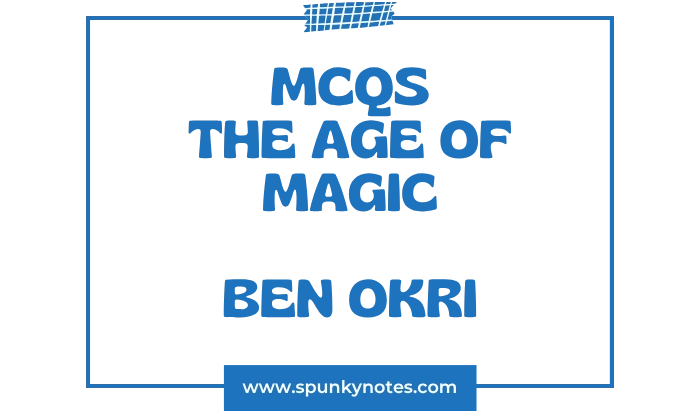

Estimated Reading Time: 17 min
The Age of Magic MCQs
1. Where was the crew traveling when Lao first spoke to the Quylph?
A. London to Paris
B. Basel to Goetheanum
C. Paris to Switzerland
D. Waterloo to Paris
2. Who did the Quylph suggest Lao might be afraid of?
A. Jim
B. Life
C. Malasso
D. The camera
3. What did the Quylph say was the luckiest thing for a person?
A. To be rich
B. To be loved
C. To be at home everywhere
D. To be consistent
4. What was the actual goal of the documentary journey, according to Lao?
A. To find wealth
B. To film famous people
C. A journey to an idea
D. To stop Malasso
5. What quality did Lao believe personality was the outward presence of?
A. Inner accomplishment
B. Talent
C. Wealth
D. Societal pressure
6. What societal method did Lao believe was essential for success in cynical times?
A. Ardent belief
B. Fine hypocrisy
C. Extreme honesty
D. Strong enthusiasm
7. What did Jim whisper to Lao during the interview that made Lao uneasy?
A. To smile more
B. To restate his theme
C. To look at Barbara
D. That they were failing
8. What was Scott’s theory about why civilizations keep losing their “best dreams”?
A. Ill luck
B. Greed, power, corruption
C. Poor leadership
D. Bad weather
9. Who was the “silent one” from New York whose words brought peace to the conversation?
A. Barbara
B. Emily
C. Husk
D. Jute
10. What did Lao think was the best thing about death?
A. Immortality
B. Having lived fully
C. Resting
D. Seeing God
11. What word did Lao realize was the inverse of “live”?
A. Died
B. Evil
C. Fear
D. Lie
12. What was the source of Lao’s gloominess on the train, visually?
A. Malasso’s presence
B. Urban ruins tumbling past
C. The fight with Mistletoe
D. Jim’s laughter
13. What did Lao do to Mistletoe in his “eviling” mood?
A. Criticized her
B. Remade her in malice
C. Ignored her
D. Asked her to leave
14. What entities did Lao see crowding the compartment during the tunnel blackout?
A. The Quylphs
B. Monsters of guilt and fear
C. Tourists
D. Shadowy police
15. What mythological setting did Lao slip into while gazing at the station clock?
A. The Garden of Eden
B. The mythical world of the giant ice-cube
C. The realm of Malasso
D. Hades
16. What did Lao realize was woven into the fiber of all things in the original garden?
A. Pain
B. Silence
C. Freedom
D. Chaos
17. What did the crew’s heavy luggage ultimately symbolize, according to Lao?
A. Their wealth
B. Their growing strength
C. Their sins in Hades
D. Their secrets
18. What did Lao realize the monsters were doing on the station platform?
A. Attacking the crew
B. Getting acquainted and chatting
C. Hiding
D. Waiting for Malasso
19. What did Lao realize was the first freedom a person could achieve?
A. Freedom of movement
B. Freedom of mind
C. Freedom from money
D. Freedom from the camera
20. What specific moment did Lao lose when linking the present to the past at Basel station?
A. The moment he saw the Devil
B. The golden moment
C. The moment of the curse
D. The moment of clarity
21. What did the travellers staring at the consoles remind Lao of?
A. Shepherds reading a tomb inscription
B. Students reading textbooks
C. Thieves looking for treasure
D. Gods judging mánkind
22. What phrase was written on the tomb in Poussin’s painting, Et in Arcadia ego?
A. I, too, have lived in Arcadia
B. Seek the gold
C. Death is inevitable
D. Where do we go next
23. What shocking phrase did Lao see written vertically in Jim’s notebook?
A. LOVE MISTLETOE
B. SELL HIS SOUL
C. KILL MALASSO
D. GO TO ARCADIA
24. What poetic form did Jim use to compose from the letters of “KILL MALASSO”?
A. Haiku
B. Sonnet
C. Acrostic poem
D. Free verse
25. What did Lao suspect had happened to Jim after reading his list and hearing his laughter?
A. He was arrested
B. He was cracked
C. He found Malasso
D. He was cured
26. What quality did Jim possess that Lao suspected lay behind his outwardly jovial aspect?
A. Ambition
B. Secret cowardice
C. Genius
D. Kindness
27. What was Jim’s primary motivation for writing his extensive lists of hatred?
A. To insult others
B. To escape his narrow condition
C. To punish himself
D. To seek fame
28. Why did the Devil refuse to buy Jim’s soul?
A. It was too valuable
B. It was too mild
C. It was already sold
D. He wanted Malasso’s soul
29. What specific sense did the Devil use to seduce Jim?
A. Power
B. Serenity
C. Wealth
D. Lies
30. Why was Jute crying during the discussion about the Arcadia journey proposal?
A. She was afraid of Malasso
B. She was happy to go
C. She couldn’t control her emotions
D. She had lost her job
31. What did Jute fall instantly in love with regarding Hans, the hotel owner?
A. His arrogance
B. His wealth
C. His fine moustache and genial face
D. His rude manners
32. What specific sight did Jute’s mother’s harshness destroy her belief in?
A. Her family’s wealth
B. An angel flying out of a book
C. Her ambition
D. Her memory
33. What did a soothing voice coax Jute to do while she stared at the lake?
A. Confess her sins
B. Jump into the lake and die happily
C. Call Malasso
D. Tell Hans she loved him
34. What did Lao claim was the quality that was higher and more powerful than will?
A. Freedom
B. Will’s junior partner
C. Discipline
D. Love
35. What did Jim claim the will built?
A. Machines
B. Nations, empires, and civilizations
C. Wealth
D. Great art
36. What did Jim say distinguishes those who succeed from those who fail?
A. Wealth
B. Will
C. Intelligence
D. Reason
37. What type of work did Mistletoe produce in her vision after being touched by the wand?
A. Poetry
B. Drawings that became real
C. Music
D. Sculptures
38. What was the name of the book Mistletoe drew the title for in her vision?
A. Et in Arcadia Ego
B. The Age of Magic
C. Astonishing the Gods
D. The Book of Life
39. What did Lao realize was the destination of his fall into Malasso’s first map?
A. The ocean
B. The original garden
C. The precise point he started from
D. The palace
40. What was the shocking quality of the “transformed Lao” who emerged from the tomb?
A. His cruelty
B. His silence
C. His tranquillity
D. His great size
41. What warning did the dwarf-like figure give Lao on the mountain?
A. He would become a hero
B. He would lose his mind
C. He would find Malasso
D. He would become rich
42. What did Lao conclude about the back view of suburban houses from the train?
A. They were full of dreams
B. They were full of money
C. They were a mirror of our receding soul
D. They represented success
43. What did Jute’s mother’s whispers help her prepare for?
A. Her career success
B. Events to come
C. Her own death
D. Her skepticism
44. What was the traditional birthplace of Hermes, according to legend?
A. Eden
B. The Peloponnese
C. Arcadia
D. Babylon
45. What did the darkness force Jute to reveal while in the tunnel?
A. She was Malasso’s spy
B. She had the map Malasso wanted
C. She was the Archangel of Invisibility
D. She was pregnant
46. What did Lao conclude about the most enduring things in the world?
A. They are found in visible triumphs.
B. They dwell in the invisible realm.
C. They are made of gold.
D. They are the simplest things.
47. What did the man on the floating litter say she desired?
A. To find true love
B. Illusion, ugliness, and suffering
C. To be taken to the palace
D. To be left alone
48. What did the dwarf-like figure warn would happen if the protagonist stayed too long on the island?
A. He would become rich
B. He would lose his mind
C. He would find Malasso
D. He would become rich
49. What new quality did the mysterious woman’s curse bestow upon the protagonist?
A. Eternal wealth
B. Loss of invisibility
C. Having to love without illusion
D. Endless yearning
50. What did Lao believe was the secret law underlying the perfect harmony of the quiet street?
A. Love
B. The management of his mind
C. Wildness
D. Creativity
Brief Overview
The Age of Magic is a novel by Ben Okri, first published in 2014. The narrative is a philosophical fable that follows the journey of a documentary filmmaker named Alec. The novel is an allegorical quest to find a hidden, magical community, exploring the nature of art, reality, and genuine happiness.
Alec is a disenchanted filmmaker who is asked to make a documentary about a legendary, beautiful, and happy community that is hidden somewhere in Switzerland. Alec accepts the vague assignment, hoping to escape his own troubled life. He views the project as a search for a lost, true paradise.
His journey quickly becomes spiritual. He travels through various European towns, but he struggles with his own cynicism and his inability to perceive the reality around him truly. The novel raises the question of whether magic is something found outside the self or something that must be generated internally.
Alec meets strange, symbolic characters who offer him cryptic guidance. He learns that the most significant barrier to finding this magical community is his own disbelief and his focus on material things. The search is complicated by the interference of a rival crew member who represents commercialism and false art.
The novel suggests that the “Age of Magic” is not a specific historical period, but rather a state of mind. It is achieved when one lives authentically and embraces mystery. The book concludes with Alec undergoing a profound internal transformation, realizing that the greatest art is the art of truly seeing the world.


